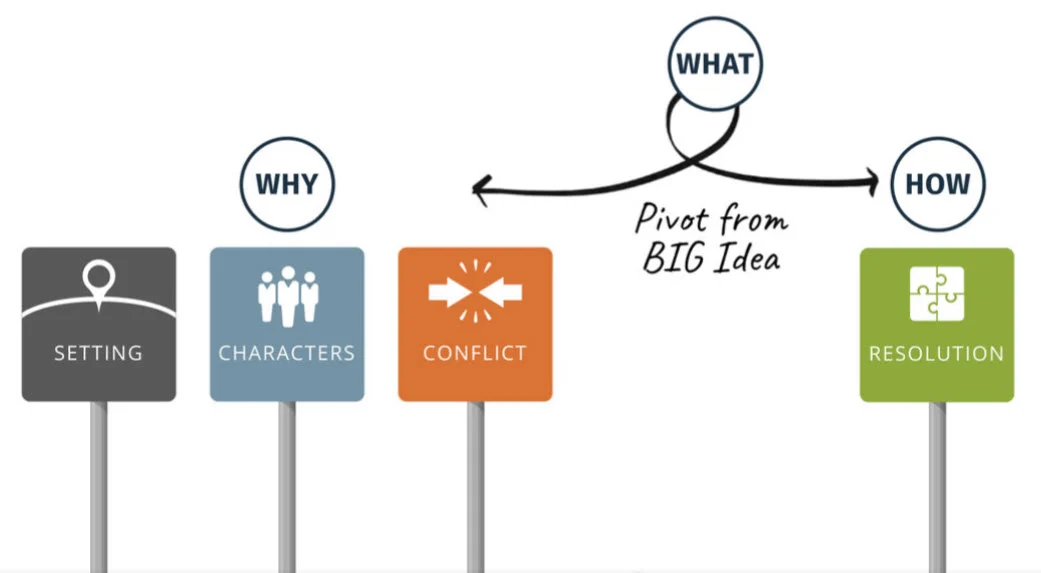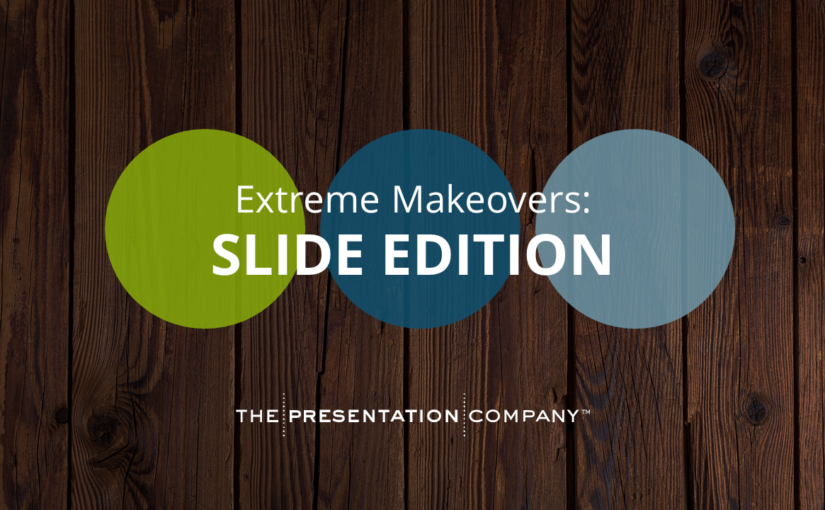Think about the last time you were “wowed” by someone in business. Was it the way they navigated difficult questions? How they commanded the room (or perhaps even the “virtual room”)? Or was it simply the way they kept the conversation focused?
If you’ve ever wondered what gives certain people that je ne sais quoi we call “executive presence”, this guide is for you.
To those that don’t have it (yet), executive presence may seem like a superpower that some are born with. It’s not. Anybody can learn how to have executive presence. It requires preparation in three crucial ways:
- Get clear on your main points
- Use a storytelling framework for navigating these points
- Most importantly, deeply think about the needs of your audience
This guide will help you learn key skills for developing executive presence and arm you with strategies to help you naturally “own the room”, whether you’re selling your ideas in person or online. These skills will give you – and your audience – focus and control over your ideas, providing you with the confidence and poise that will highlight your authority on the subject. (Not to mention, it’s a surefire way to significantly boost your career!)
Let’s dig in.
What is executive presence?

Executive presence is the aura of confidence, authority, and self-assuredness that (typically) separates senior-level people from entry-level individuals. Another way to describe executive presence is gravitas, which comes directly from the Roman language meaning “dignified and serious conduct”.
Today, gravitas is used to describe an authoritative manner that “commands the room” and grabs your audience’s attention. In the office, having gravitas or executive presence is recognized as an important differentiator in realizing your career potential.
What are the qualities of executive presence?
Those with executive presence are confident, well-prepared and can clearly articulate their ideas. This is not the same as being smart or having technical skills. Often people with a ton of knowledge struggle to communicate their ideas tactfully. They may share mounds of data or spew endless facts that, ultimately, aren’t digestible because they don’t keep their audience top of mind. Ironically, sometimes it can be more powerful to share less information, when that information is concise and directly relevant to the topic at hand.
Executive presence can even shine through during virtual meetings. How? Much like a face-to-face environment, online presenters must know their story backwards and forwards, be prepared to create a two-way dialogue with their audience, and know how to be nimble and responsive. These skills are a recipe for letting your virtual presence soar.
Why is executive presence important?
Strong executive presence will bring notice to your ideas, recommendations, proposals, or truly any kind of business communication. It is one of the critical differences between an experienced communicator and an inexperienced one. Executive presence showcases the confidence you feel in yourself and your material, which in turn, builds confidence that others have in you, your ideas, your reputation, and your company. Simply put, executive presence is a career game changer.
Great. So how do I improve my executive presence?
There are four essential ways you can instantly improve your executive presence.
Use a story framework
Much like your favorite book, movie or TV show, business stories have four key components: setting, characters, conflict, and resolution. When you apply a business storytelling framework to your ideas, it helps you choreograph your insights, facts, and data in a way that flows seamlessly and commands the attention of your audience. Why? Because stories are the best way to contextualize information and make it memorable. They offer the presenter and the audience a roadmap of where the narrative is going and where it’s been.
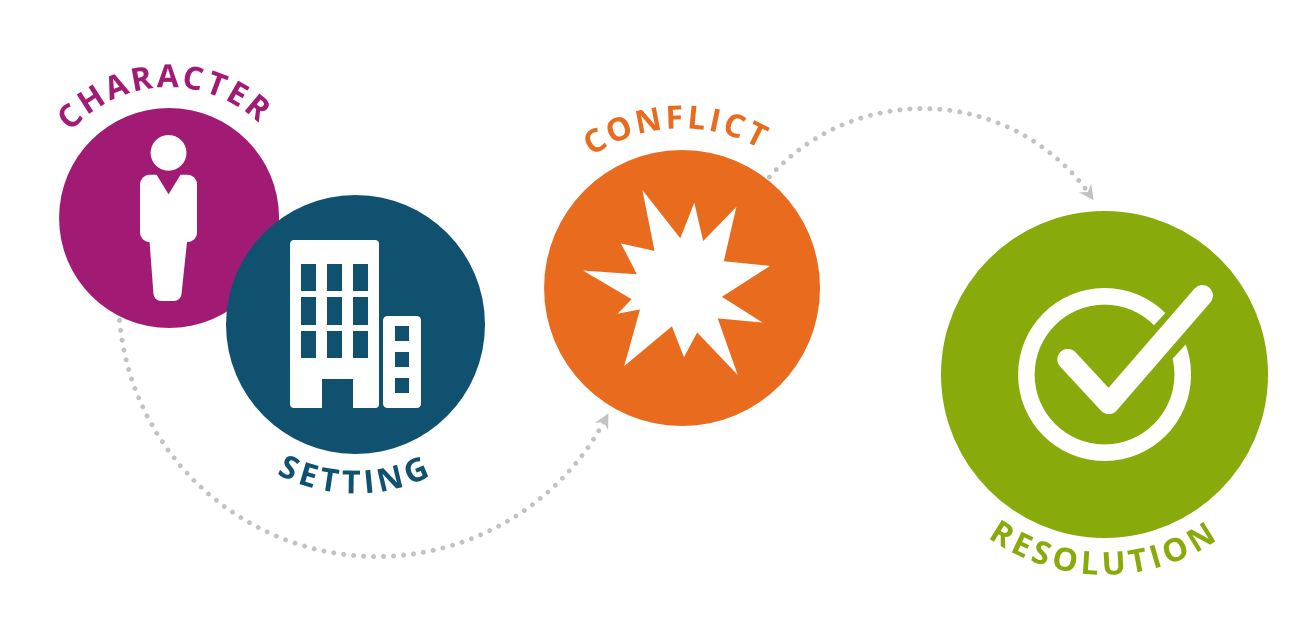
Following this structure results in greater control over your material, keeping you in the driver’s seat throughout your presentation. Having this guide as a “safety net” also does wonders for your level of confidence which, of course, boosts your executive presence.
Have a BIG Idea
One of the key elements of your story framework is a BIG Idea. It’s the ONE most important thing you want your audience to remember. Keep in mind: This is not the name and details of your product, solutions, or recommendations. Your BIG Idea is a simple, concise sentence about WHAT your presentation is about, and includes one to three benefits that are relevant to the audience. It links WHY your audience should care to HOW you plan to implement next steps.
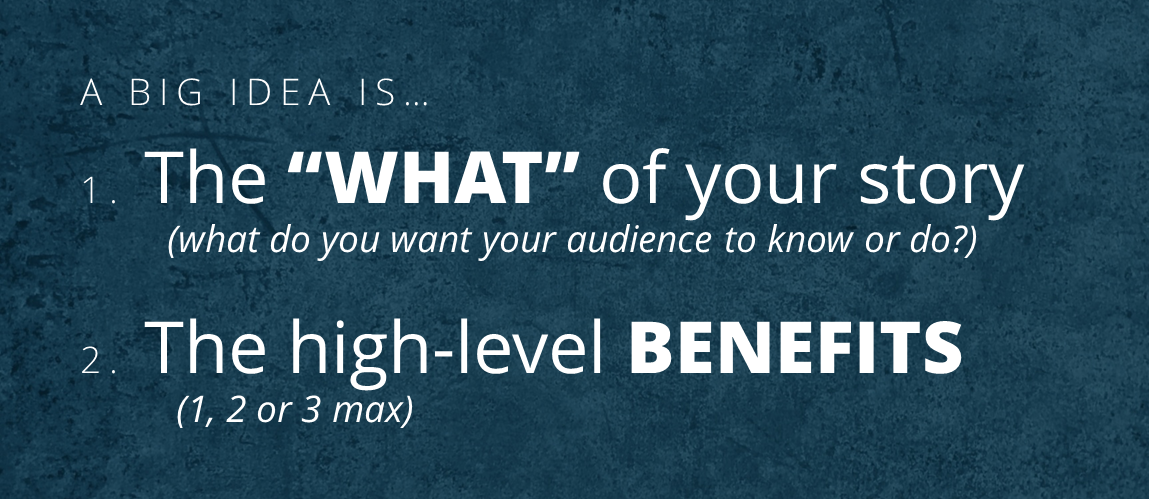
Some examples of BIG Ideas include:
- We need to implement the performance tracking dashboard to improve business results
- Embracing sustainability will help us meet customer demands and protect our leadership position
- We ought to give our clients a compelling reason to share and retweet by creating content that sticks
Why does having a BIG Idea improve executive presence? If you isolate your BIG Idea before approaching your audience, you’re much more likely to present a clear, simple, memorable message that they can act on. The more you cut through the noise (either in your own head or from outside) will give you and your ideas powerful focus. Focus and clarity goes a long way in enhancing your executive presence.
For visual presentations, always use active headlines
A potent tool to guide your story is using headlines for every slide you present. Headlines should be similar to any headline you see in a news article: It’s the most important message placed at the top of the slide. It’s an excellent mechanism to guide your story and ensure information is clear at-a-glance.
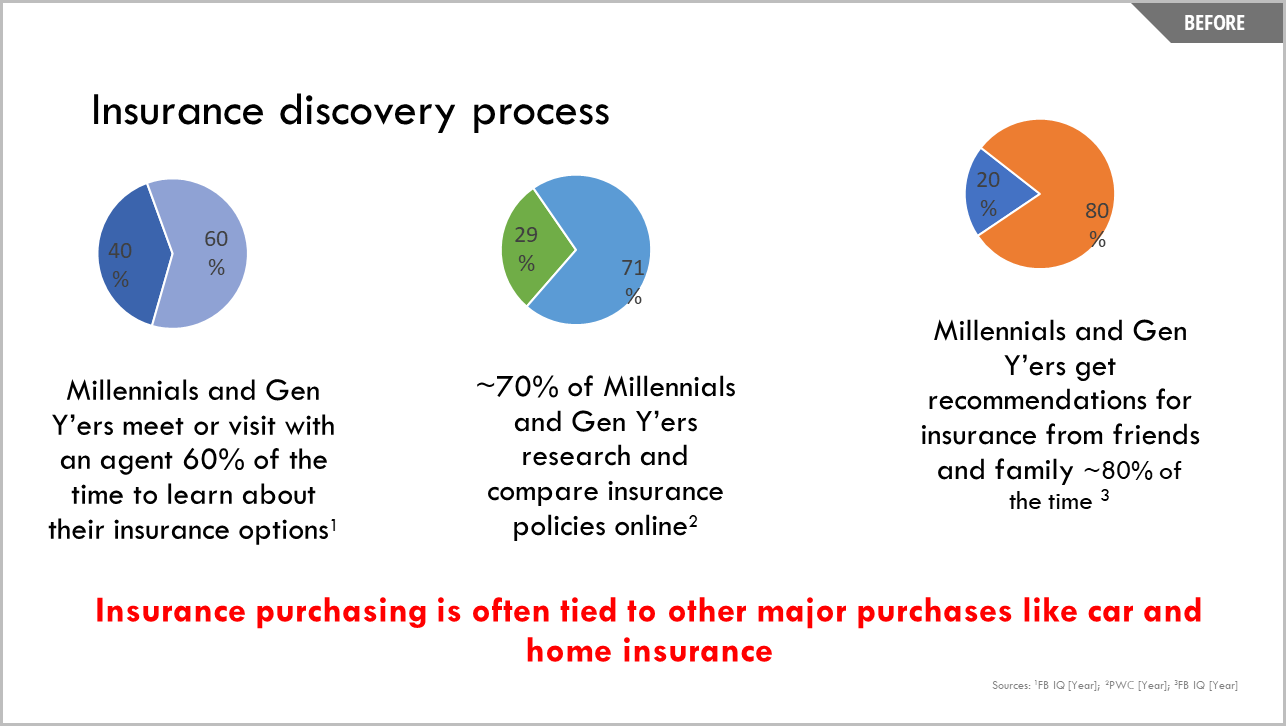
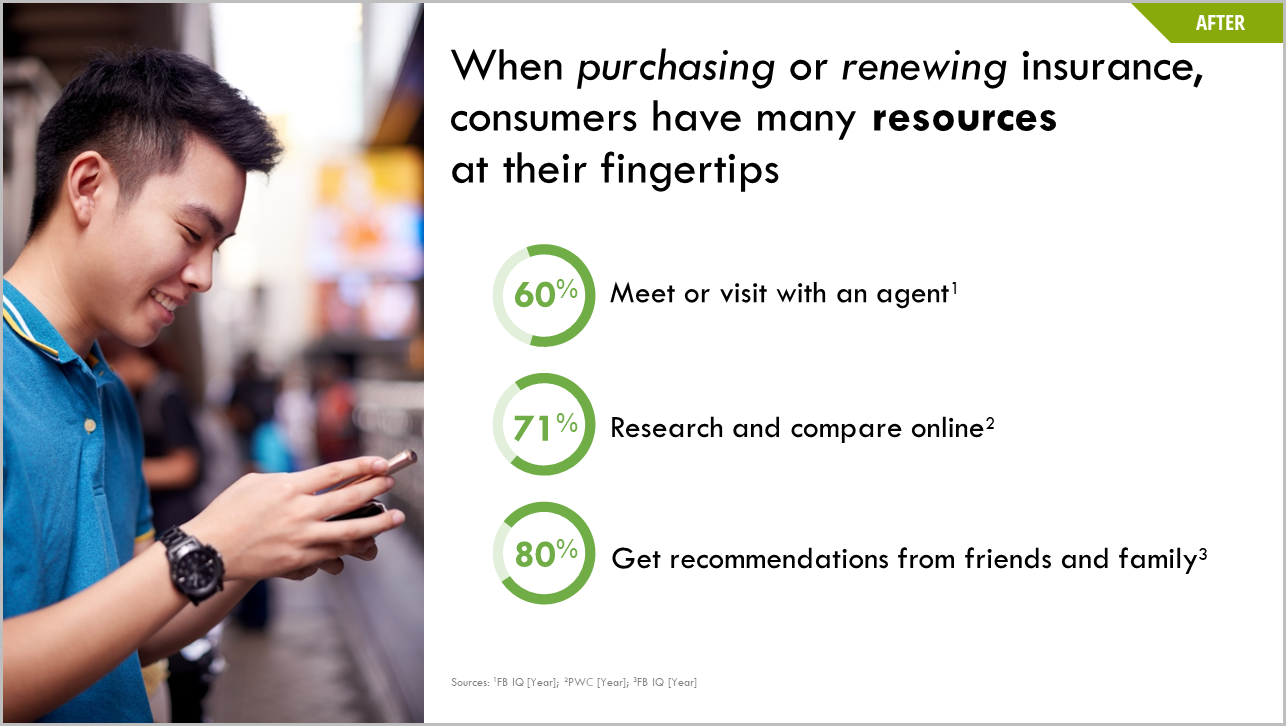 As you can see above, the original slide offers a generic heading that doesn’t clearly further the narrative. The updated slide moves the narrative forward with an insightful message at the top. In essence, headlines provide cues, which keep you oriented on a clear path throughout your presentation. Knowing exactly where you’re going gives you assuredness, and this confidence is a key driver of executive presence.
As you can see above, the original slide offers a generic heading that doesn’t clearly further the narrative. The updated slide moves the narrative forward with an insightful message at the top. In essence, headlines provide cues, which keep you oriented on a clear path throughout your presentation. Knowing exactly where you’re going gives you assuredness, and this confidence is a key driver of executive presence.
Know your audience
One of the best ways to elevate executive presence is to know your audience. As you prepare for any business communication, anticipate questions you might get. Remember: The best presenters facilitate a two-way dialogue—not a monologue! Envision where even the sharpest folks might have trouble making a connection from one of your points to another, prepare to be nimble and be ready to pivot based on where the conversation leads (more on pivoting below).
This is particularly important when facing executives. They are experts at finding holes in logic, spotty research, or pointing out problematic conclusions. If you have thought through potential questions and points of contention, you will be well-prepared to respond.
It’s a good rule of thumb to not only expect to be interrupted throughout a discussion or presentation, but to actually invite interruption. Building in moments to check-in with your audience will ensure you have an open dialogue and allows you to zig and zag based on audience needs. Speaking of zigging and zagging, let’s talk about the pivot…
What is the “pivot” and how does it help my executive presence?
The pivot strategy is a technique that gives you the best chance to address audience needs real-time. How? It starts with making sure you’re armed with supporting data for anything you present, especially if it’s counter-intuitive, unexpected, challenging to current opinions and practices, or expected to result in major change.
A smart strategy is to keep the supporting data in hidden “drill-down” slides which are a simply click away should your audience want to dive deeper. You should always be ready to skip ahead, jump back, or dig in deeper depending on where the audience wants to go. People can boost their executive presence simple by showing they are nimble and quick to respond to their audience.
How can I boost my executive presence in a virtual environment?
The virtual world can leave us feeling blind by removing cues (like body language or normal conversation) to help us gauge our audience. To fill the blind spots, you must find a way to build a connection with your audience, regularly opening up the floor for interaction in a natural— yet controlled—way.
You can build frequent opportunities for interaction directly into your story using interactive placeholder slides. What are interactive placeholders? At the core, they’re presentation slides that “direct virtual traffic.” They visually show your audience what they need to know or do at any given moment. These visual pauses might signal a break for Q&A, a quick poll to check the audience’s understanding, a discussion in chat, a virtual whiteboard brainstorming session, or even breakout rooms for small group exercises. Interactive placeholder slides guarantee valuable feedback opportunities that will help you discover and directly address your audience’s needs.
Another way to boost your virtual presence is to verbally reinforce what your interactive placeholder slides are communicating visually onscreen. Why? Because you can expect some awkward silence when launching a poll, or pausing for Q&A, etc. Your audience needs a moment to think and process what you just asked them to do. Therefore, be ready with pre-scripted language prompts to fill the void.
What is different about the mindset of someone with strong executive presence?

Generally, people with strong executive presence think big picture and long-term. They always present vision before details. They may frame their ideas in the context of growth, profitability, and competitive advantage. After that, they’re thinking of the company’s key strategic initiatives and the specific measurable goals of their business unit. Think like an executive (even if you aren’t one) by understanding corporate vision, mission and values.
How can I (and my team) gain executive presence quickly?
One of the best ways to learn executive presence is by mastering business storytelling. Once you learn to apply the framework and organize your thoughts into an audience-centric narrative, the easier it gets. The key driver of executive presence — confidence — will increase when you know how to easily flex your story, handle any audience, and motivate them to act.
The same is true for teams. When the entire team is working from a story framework and speaking a common “language”, it offers the group better control and helps avoid awkward transitions. Everyone knows where they are in the story journey at all times. An organized and coordinated team will inherently display impressive executive presence.
Companies like T-Mobile, Nestle and Facebook turn to TPC to enhance their teams’ executive presence. If you’re looking to up-level your team’s executive presence skills, learn more here.


